Designers are often asked about their sources of inspiration: travel? Trade fairs? Exchanges with others? Yes, certainly. But sometimes it's just a walk through the forest, the countryside and over the mountains. You just have to look closely.
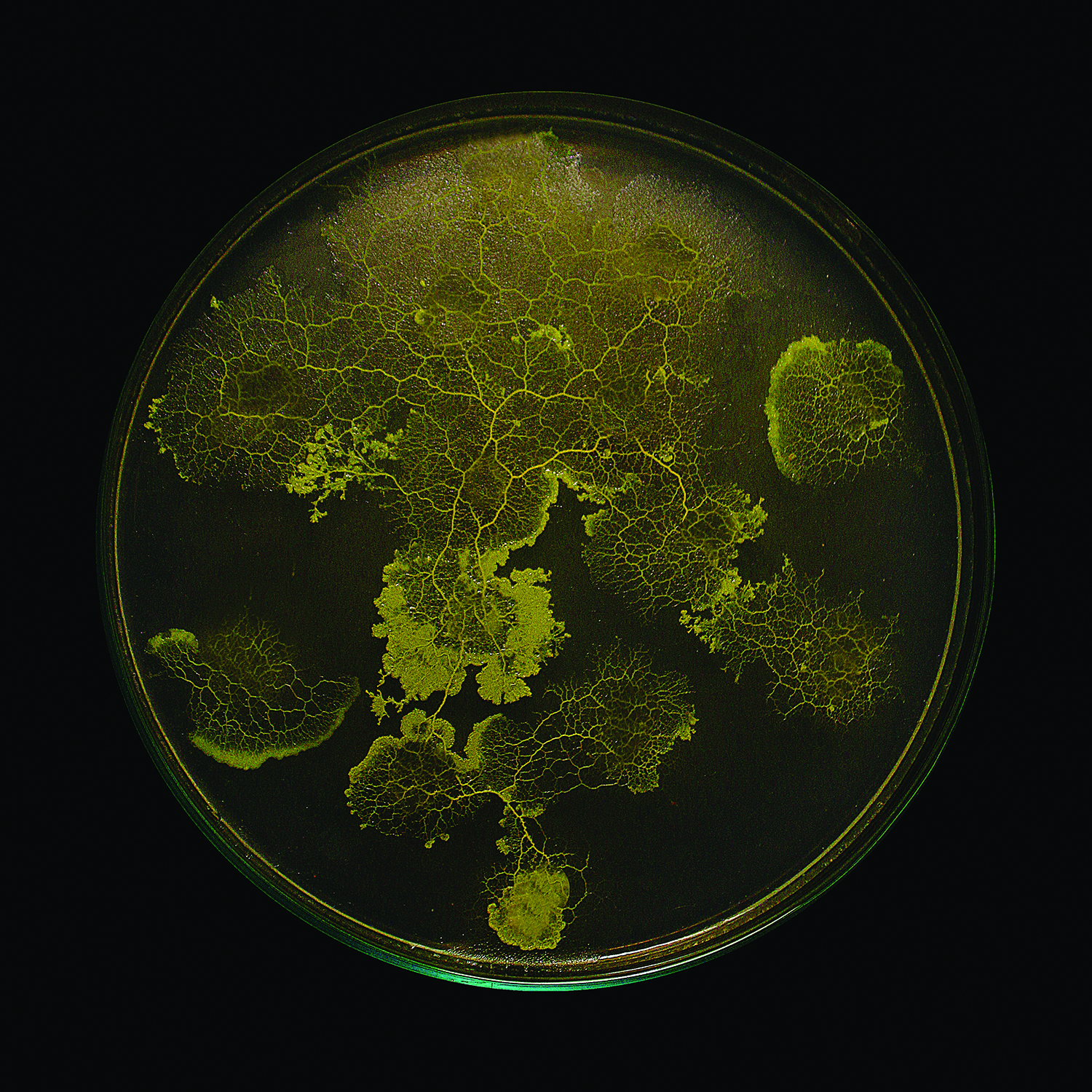
Beautiful and mysterious: The Physarum Polycephalum is used as a biological computer in this project.
© Photo: ecoLogicStudio
With the art project "Gan-Physarum: La Dérive Numérique", Claudia Pasquero and Marco Poletto, founders of the architecture and design innovation office ecoLogicStudio, dare to look into the future. To do so, they and their team were commissioned by the Centre Pompidou for the exhibition "Réseaux-Mondes" to train a machine-learning algorithm to behave like a living slime mould to represent the blue-green future of a bio-digital, autonomous Paris.
.jpg)
Complex processes: The Beaubourg district of Paris, which is also home to the Centre Pompidou, in artistic transformation by the slime mould Physarum Polycephalum.
© Photo: ecoLogicStudio
GAN stands for Generative Adversarial Network, an algorithmic architecture that uses deep-learning methods to create new generative models. This powerful form of artificial intelligence was trained by the bioinformatics design team to "behave" like a Physarum Polycephalum, a single-celled slime mould: The trained GAN-Physarum is sent through the streets of Paris. In an AI-generated video entitled “GAN-Physarum: La dérive numérique”, it shows how it decodes and reinterprets the patterns of today's Parisian urban fabric. In this way, one can observe the transition from the original morphological order to an emerging distributed network of path systems, the blue-green, humid and living infrastructure of the city of the next millennium, so to speak.
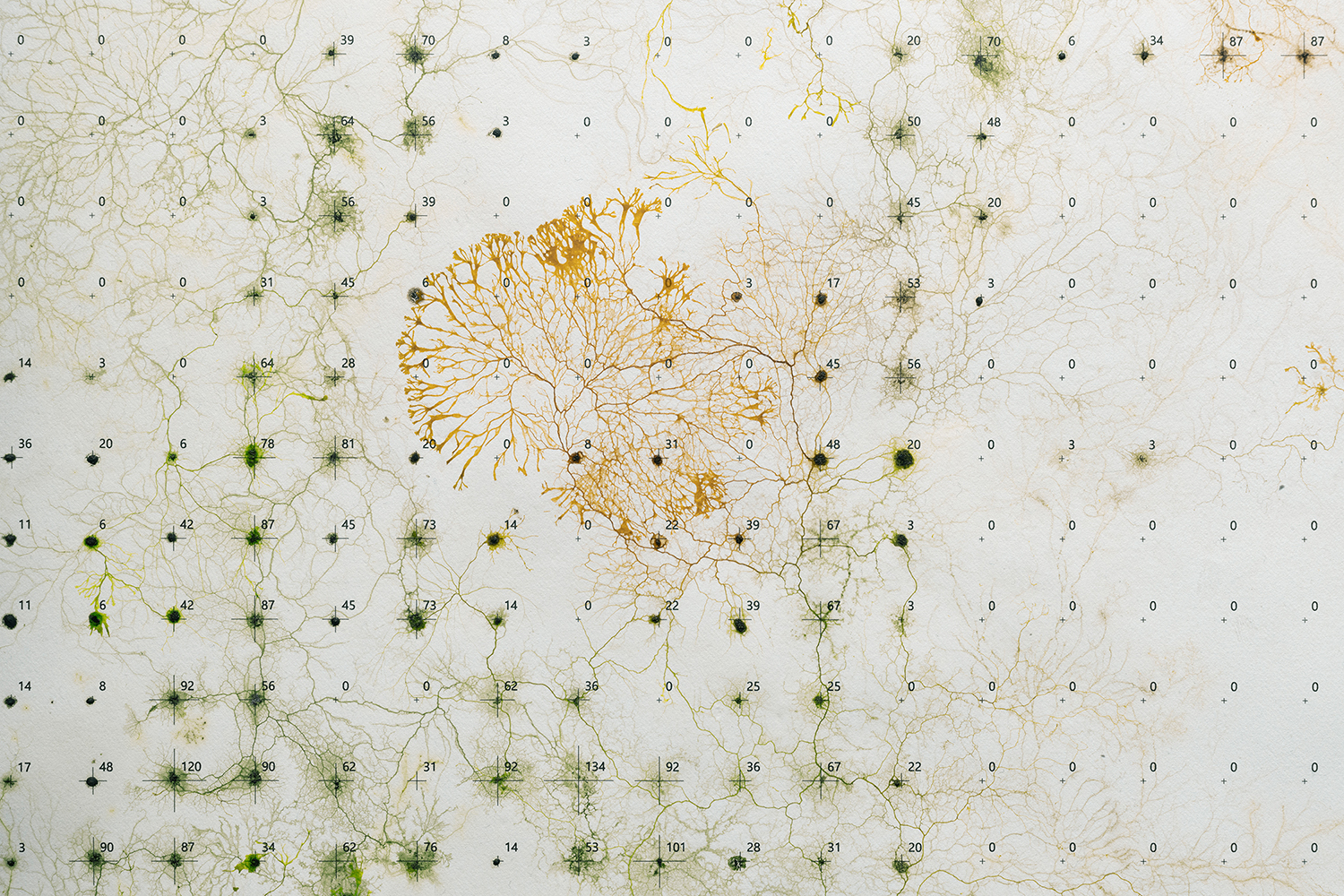
The strong statement of a biological image: The art project GAN Physarium, la dérive numeérique by ecoLogicStudio commissioned by the Centre Pompidou in Paris.
© Photo: Naaro
In addition to an AI video and a nearly one-square-metre bio-painting in which a living Physarum polycephalum stretches out its networked body to feed on a web of nutrients spread across the canvas to accurately map Paris' current biological resources, the project consists of a second video: "DeepGreen: Urbansphere". It shows the application of the GAN-Physarum algorithm to a series of projects initiated by the studio in 2019 in partnership with the United Nations Development Programme (UNDP). "Against this backdrop, we are witnessing the unfolding of a post-natural story, a time when the impact of artificial systems on the natural biosphere is global, but their action is no longer exclusively human," says Claudia Pasquero, co-founder of ecoLogicStudio and professor of biodigital architecture at UIBK and UCL. "Cities like Paris have become co-evolving networks of biological and digital intelligence, semi-autonomous synthetic organisms."
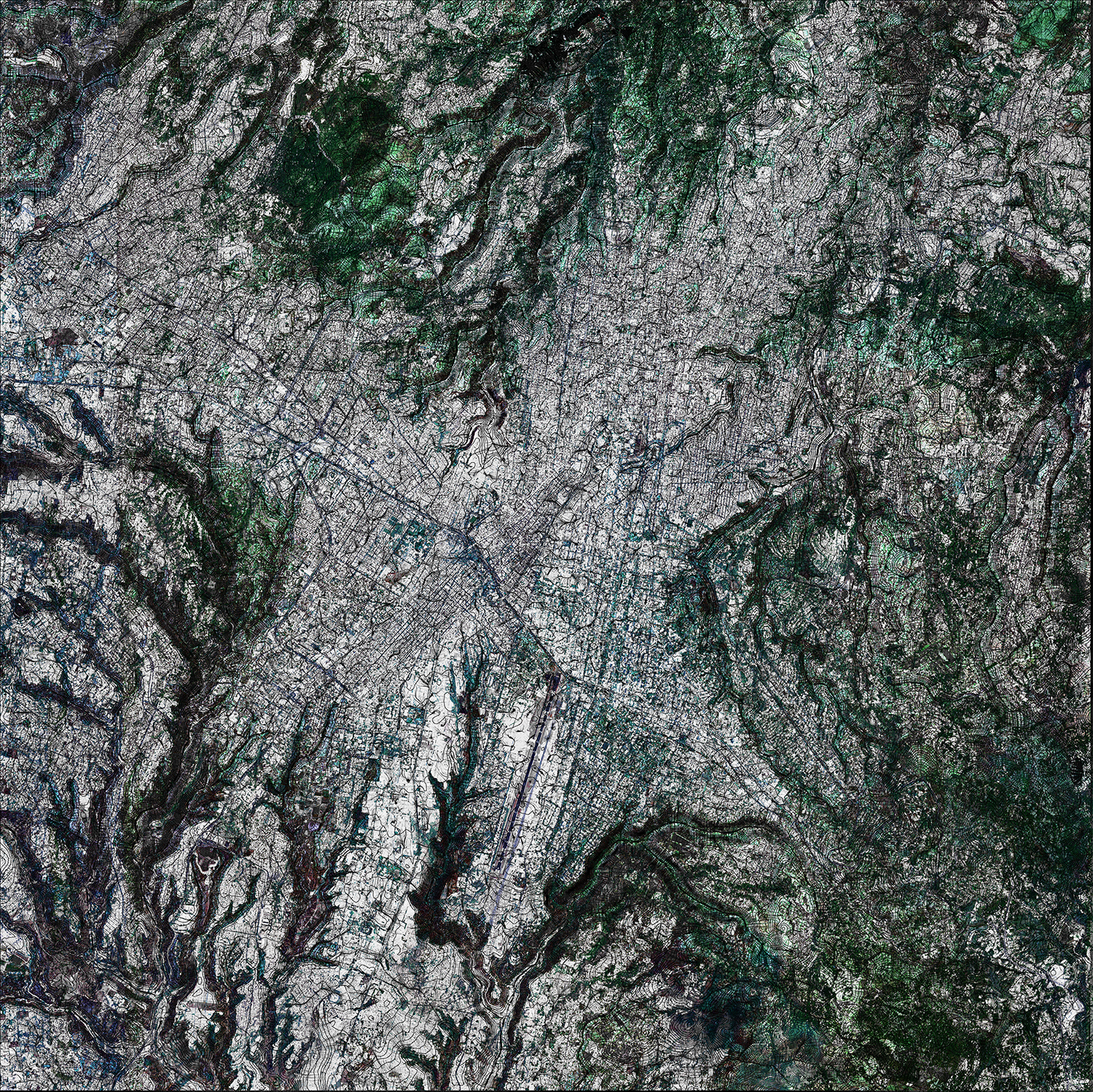
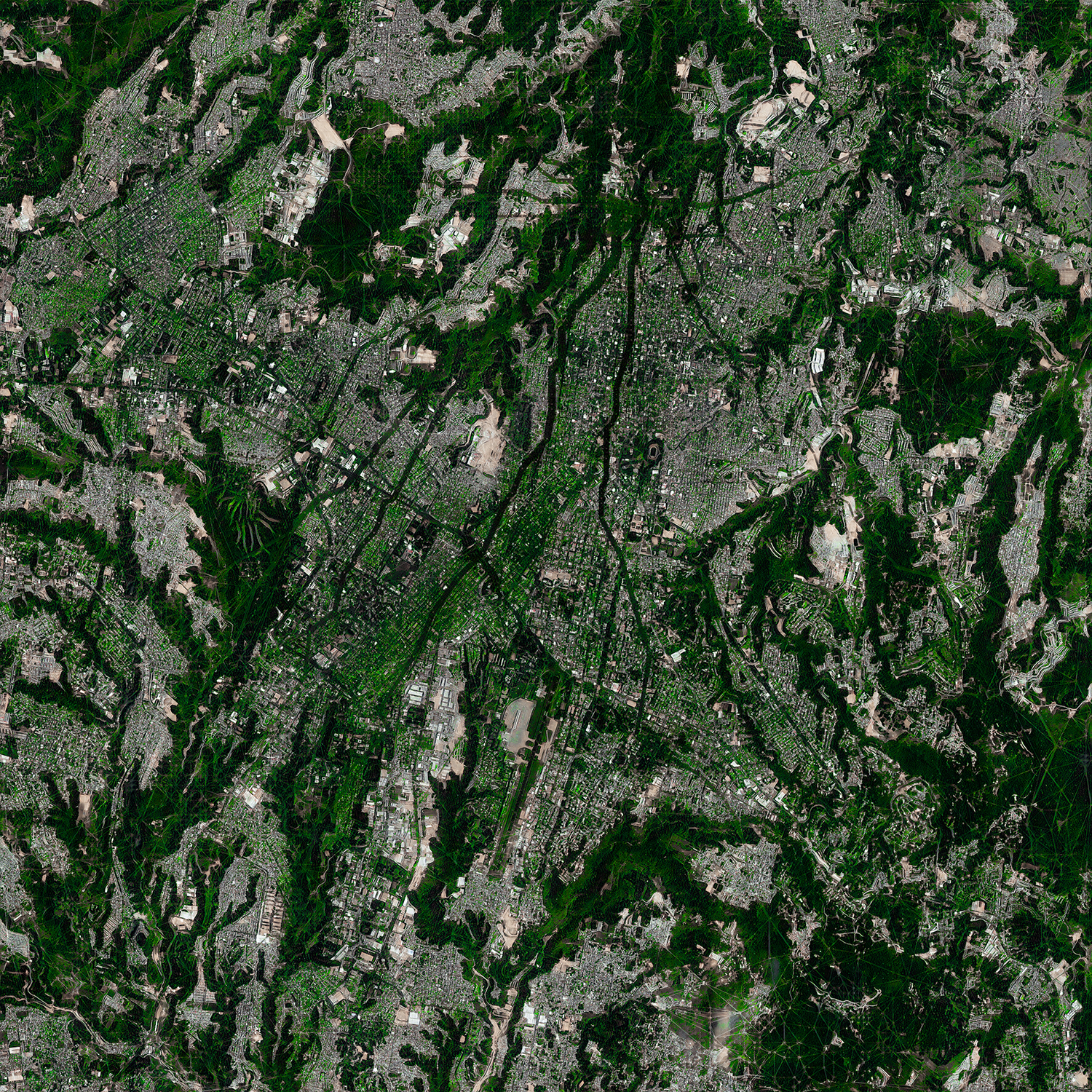
How it is and how it could be: Guatemala City in a satellite image with current vegetation and a generated view into the future for a blue-green city.
© Photo: ecoLogicStudio
DeepGreen: Urbansphere explains in detail the workflow underlying the GAN-Physarum algorithm and describes ecoLogicStudio's research into the application of Artificial Intelligence in the development of new blue-green master plans for modern cities. In particular, the case of Guatemala City is illustrated with a virtual tour of the data-driven green plan. This is a long-term project that aims to design systemic cities that use their scale and collective energy to provide refuge for both people and displaced wildlife, promote the emergence of positive microclimates, replenish depleted water sources and restore degraded terrain to reverse processes such as desertification, soil erosion and pollution. This requires innovative strategies to restore the urban environment. "With DeepGreen, we envisage an autonomous bio-digital city made for both human and non-human citizens, planned by a new form of intra-human intelligence," summarises Marco Poletto, co-founder and director of ecoLogicStudio.
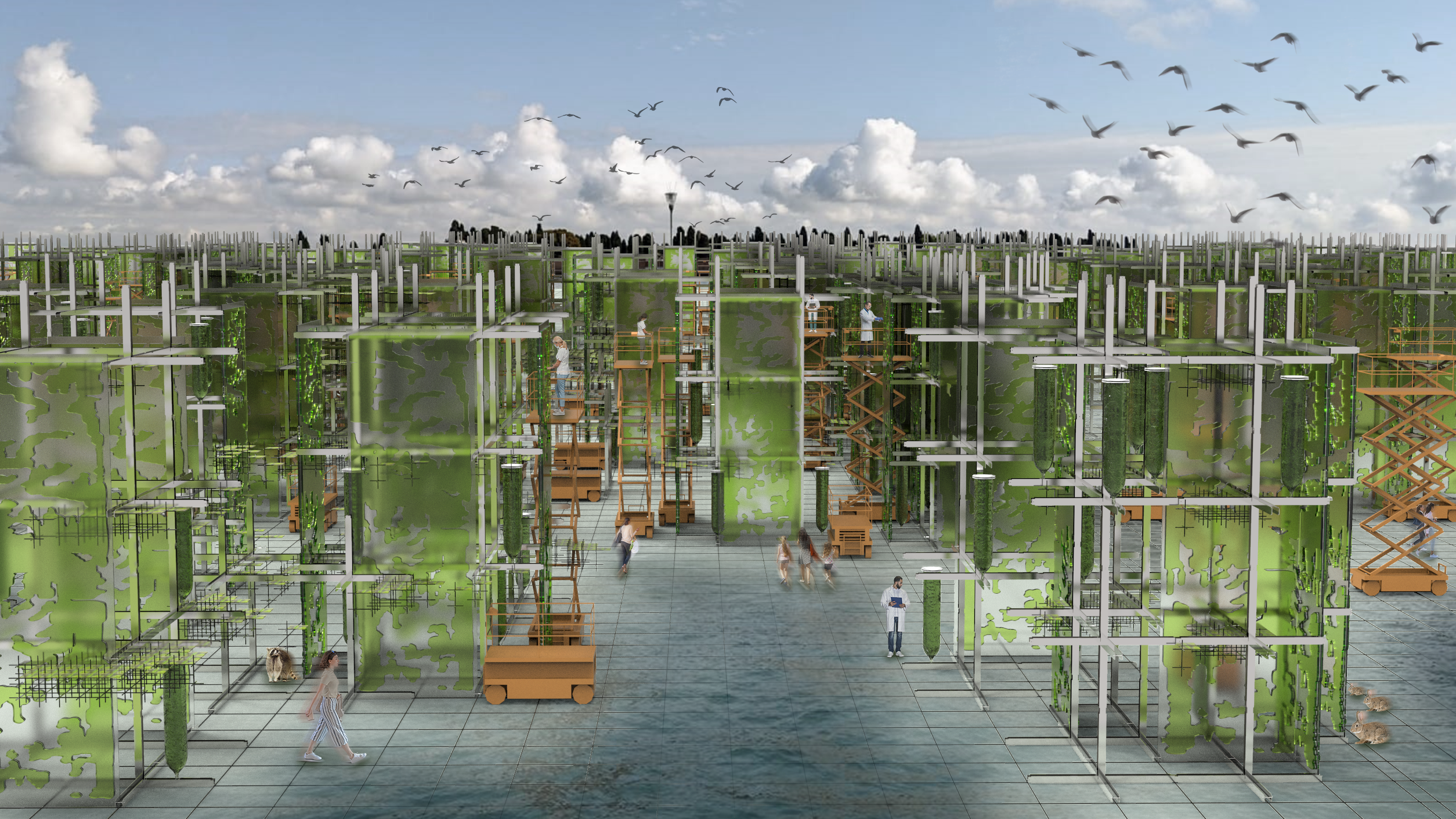
Microbiology for architecture: The air can be filtered through some kind of walls or curtains.
© Photo: ecoLogicStudio
Another applied project by ecoLogicStudio is BIT.BIO.BOT, an immersive experiment to cultivate an urban microbiome at home. The experimental space aims to test the co-existence between human and non-human organisms in the post-pandemic Urbansphere. "If we collectively, daily and locally contribute to transforming air pollutants and water contaminants into nutrient-rich foods, there will be fewer opportunities for unbalanced viral ecologies to use unsustainable food supply chains and polluted atmospheres to reach and harm our organism," Claudia Pasquero says.
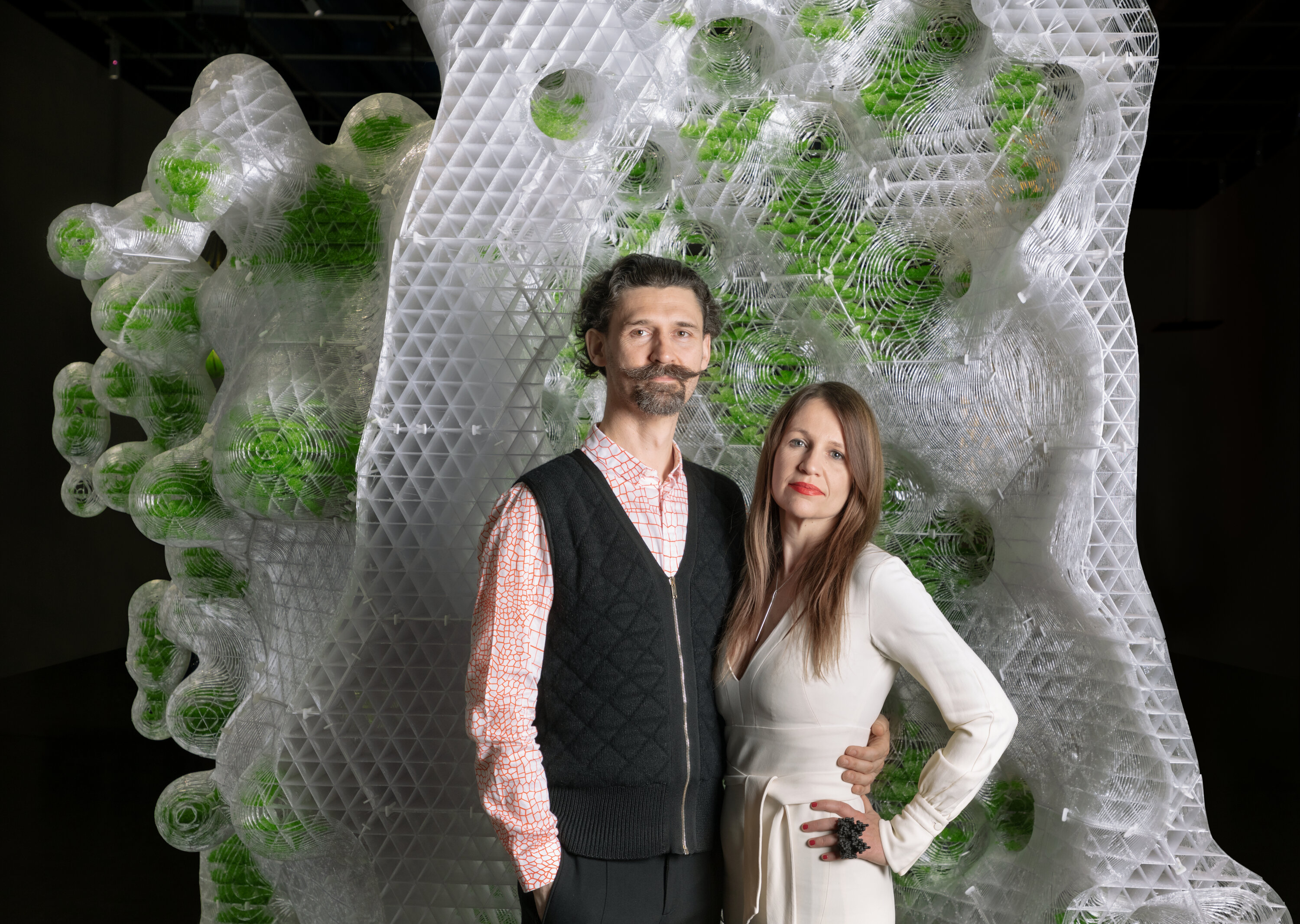
Experimenting visionaries: Marco Poletto and Claudia Pasquero, the founders of ecoLogicStudio.
© Foto: Naaro
At BIT.BIO.BOT, the urban laboratory combines advanced architecture with microbiology to create an artificial habitat managed by a series of systems that enable the cultivation of microalgae in urban spaces. The central biological mechanism here is the process of photosynthesis, driven by the sun and the metabolism of living cultures of Spirulina Platensis, single-celled microbes often referred to as blue-green microalgae, and Chlorella SP. These living organisms are among the oldest on earth and have developed a unique biological intelligence that enables them to convert solar radiation into real oxygen and biomass with unparalleled efficiency.
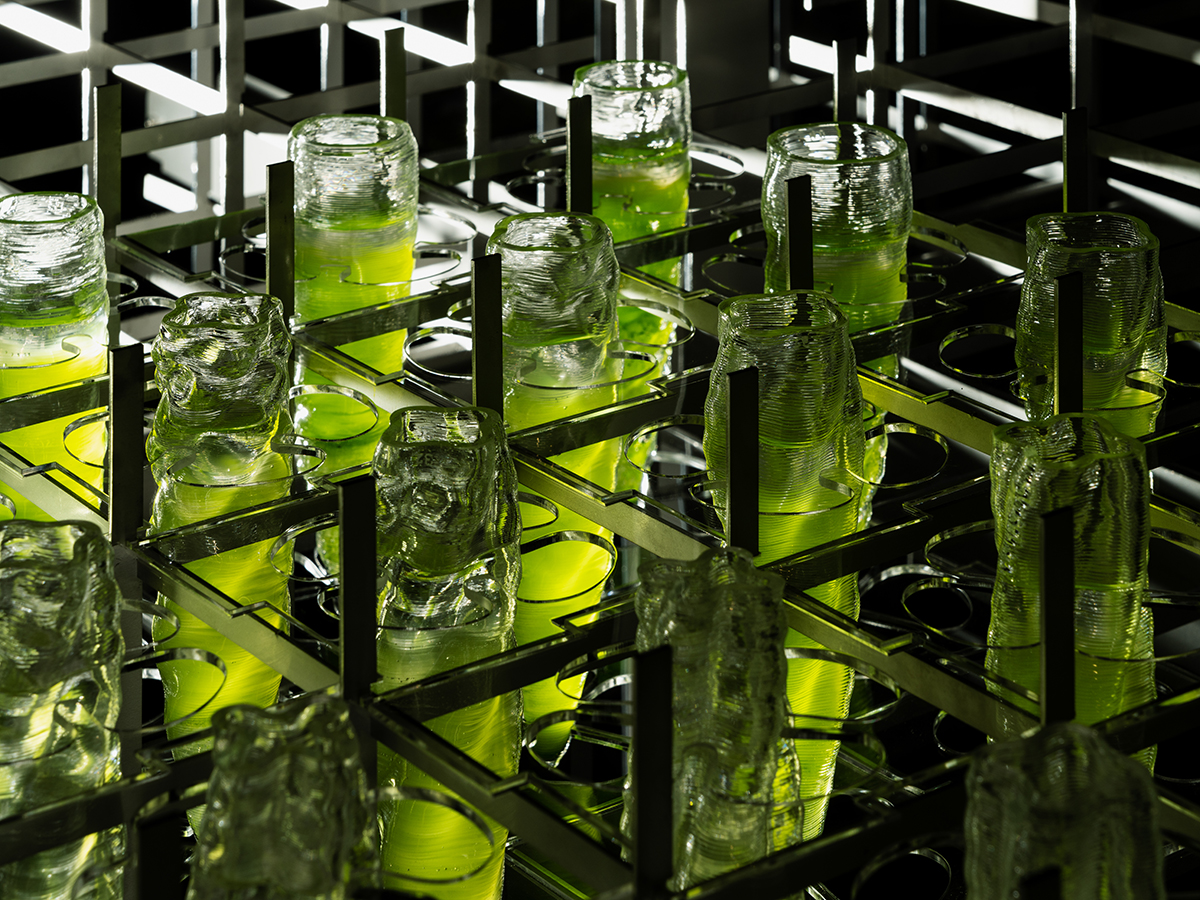
Biological intelligence: Living cultures like microalgae can convert solar radiation into oxygen and biomass.
© Photo: Marco Cappelletti
BIT.BIO.BOT consists of three fluidly interconnected systems that embody the basic architectural environments of a future home: the living façade, the vertical garden and the convivium. The Living Cladding redefines the boundaries between human and non-human areas and between interior and exterior architectural spaces. It consists of ten PhotoSynthEtica curtains. In addition, its articulation increases the interaction between the growth of the microalgae in the bio-gel medium and the environment, as well as its screening and shading potential. Each curtain is three metres high and one metre wide, with 35 metres of digital welds forming a cavity that can hold 7 litres of microalgae cultures.
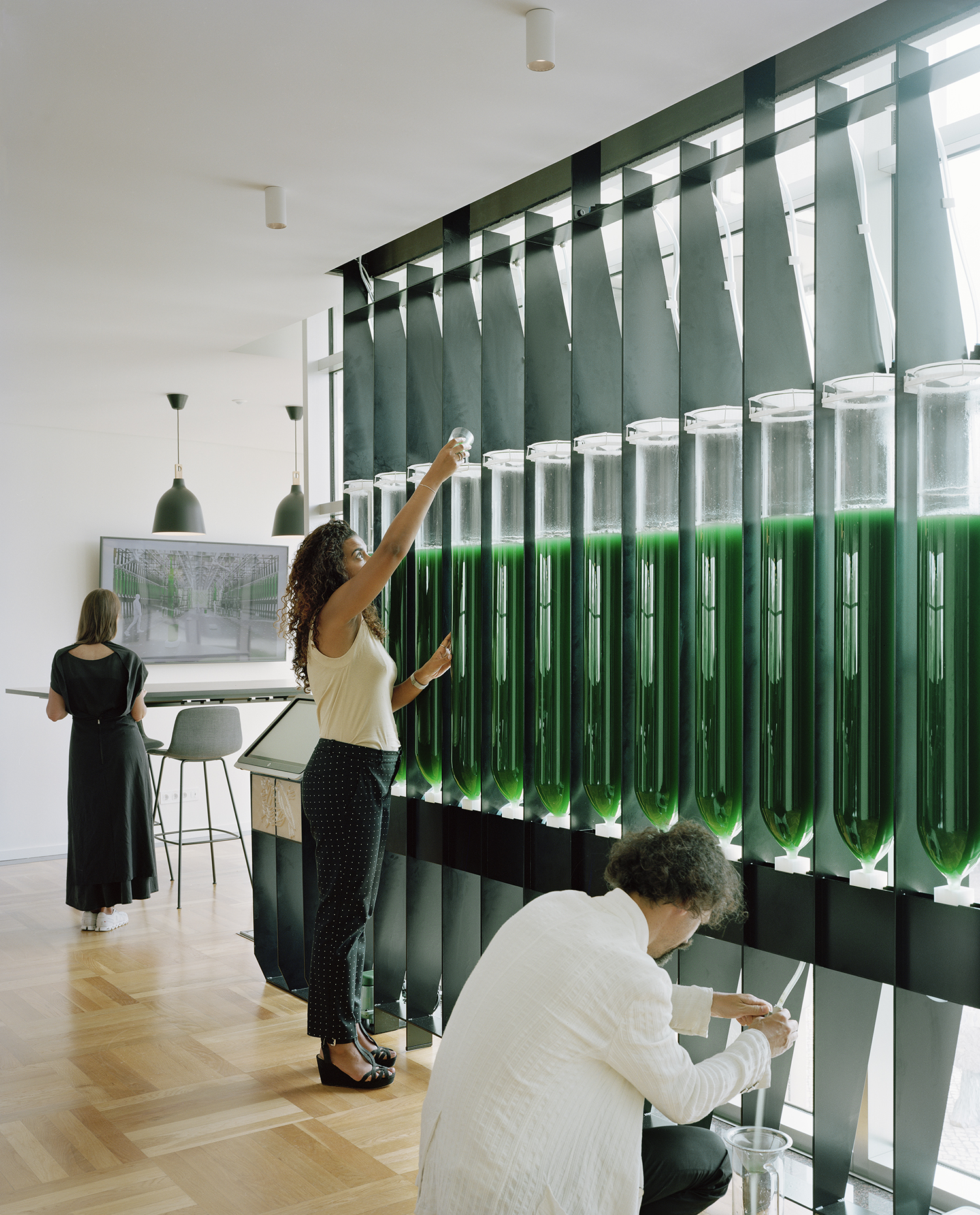
The BioFactory: A pilot project is already underway at Nestlé's headquarters in Lisbon.
© Photo: André Cepeda
The Vertical Garden - a home algae gardening system - forms a dense buffer zone between the Living Façade and the convivium, which is used for an intensive model of vertical algae cultivation. On a three-metre high and fully reversible stainless steel structure, it houses 15 bio-bombolas. Each unit is made of borosilicate glass and 3D-printed bioplastic components and houses ten litres of microalgae cultures in a highly efficient nutrient medium. The algae can be harvested independently from each unit several times a week to yield up to one hundred grams of biomass, which is the recommended daily protein intake for a family of four. During production, the Vertical Garden is able to absorb CO2 in an amount equivalent to that of three large, mature trees, providing a clear path to carbon neutrality in architecture.
.jpg)
Adrián López Velarde and Marte Cázarez, the founders of Adriano di Marti, were looking for a leather alternative without animal suffering and pollution, but of the best quality.
© Photo: Adriano di Marti
Change of scene to the other side of the earth: For Adrián López Velarde and Marte Cázarez, it all started with an awareness of a very specific problem. The textile industry is the second largest polluter on earth, and leather is the staple of this business. Most leather is sourced from cattle, using a lot of water, and it has to be tanned, using even more water. Finally, leather has to be treated with toxic chemicals that are not only bad for the environment per se, but make leather non-biodegradable. This results in 100 million tonnes of waste every year. The two entrepreneurs want to change this and therefore set out to find an alternative that does not use animal leather or synthetic leather, nor plastic bottles, which are not environmentally friendly either. So they started an intensive research into plant-based materials and found a solution that was closer than they thought: the cactus, the most common plant in Mexico. The cactus is good for the skin and does not need much water. And, it absorbs and fixes carbon dioxide.
.jpg)
Under the name Desserto, Adrián López Velarde and Marte Cázarez produce vegan imitation leather from cactus leaves, which is becoming increasingly popular not only in the fashion industry but also in the automotive and furniture industries.
© Photo: Adriano di Marti
The result is a patented material based on the cactus plant that is an alternative to animal and artificial leather. Durable and compatible with the high demands and environmental standards, such as those of the fashion industry, the planting of the cactus is designed to last for several years. This is achieved by the fact that the harvest does not damage the cactus itself. Thus, the average lifespan is about eight years. Only mature leaves are harvested and this is done in a gentle way, so the young leaves can grow back and be picked every six to eight months. This has many advantages: For example, biodiversity is recovering throughout the region, the LUC (Land Use Change) is being reversed - from intensive use back to more natural conditions. Last but not least, the original cactus cultivation typical for Mexico enriches the soil microflora. In addition, large amounts of water can be saved, as no artificial irrigation is necessary. The use of chemicals such as pesticides and insecticides can also be dispensed with. The material is washed with water, then shredded and dried in the sun for three days - which also saves energy. Through an industrial process, the proteins and fibres of the cactus are extracted to produce bio-resin. This is transformed with non-toxic chemicals into an animal-free and high-quality flexible biomaterial that is an alternative. It is moulded into the desired shape and given the desired colour. It is a material that breathes and does not stain. An important criterion is also that there is no cross-sectoral conflict, as the by-product is supplied to the food industry in a higher-quality form that is more attractive and encourages the agricultural sector to plant more cacti.
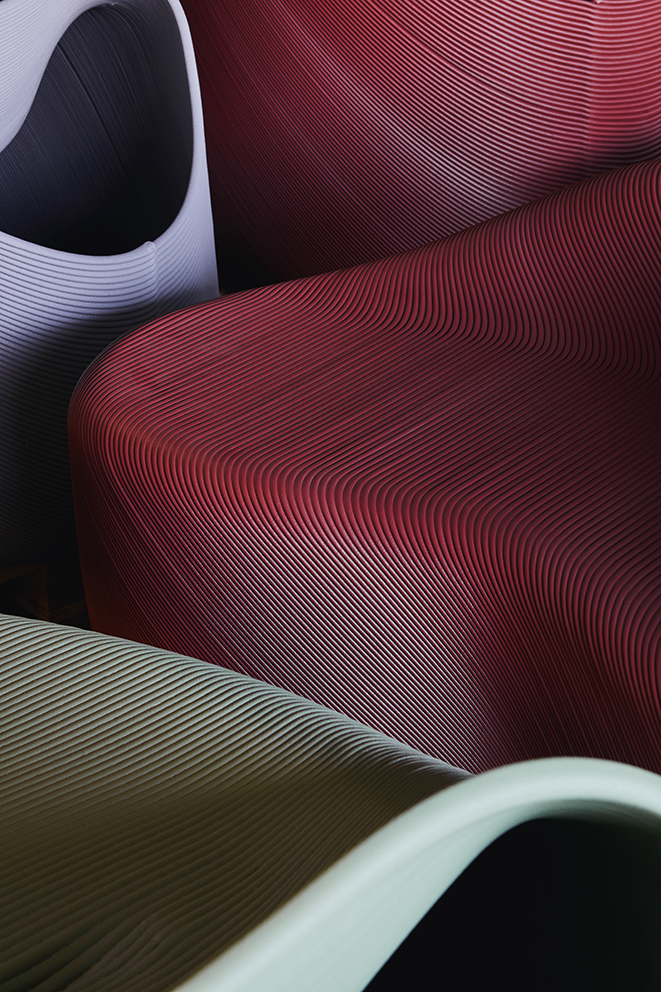
Borrows from nature to ground and soothe: The multifunctional Stratum furniture by The New Raw.
© Photo: Michele Margot
But it also works the other way around, when the artificial becomes natural. Rotterdam-based design studio The New Raw, was inspired by geological layering to create its oversized entrance furniture ‘Stratum’. The sculptural, 18-metre-long element enhances the entrance area of the new office building of a pioneering online grocery shopping company in Utrecht, the Netherlands. The largest monolithic work that the creative duo has designed to date, sets the entire space in motion - it twists, curves, folds and unfolds in different heights and widths. Designed to be multifunctional, it serves as a seat, reception, planter, standing workstation and leaning table.
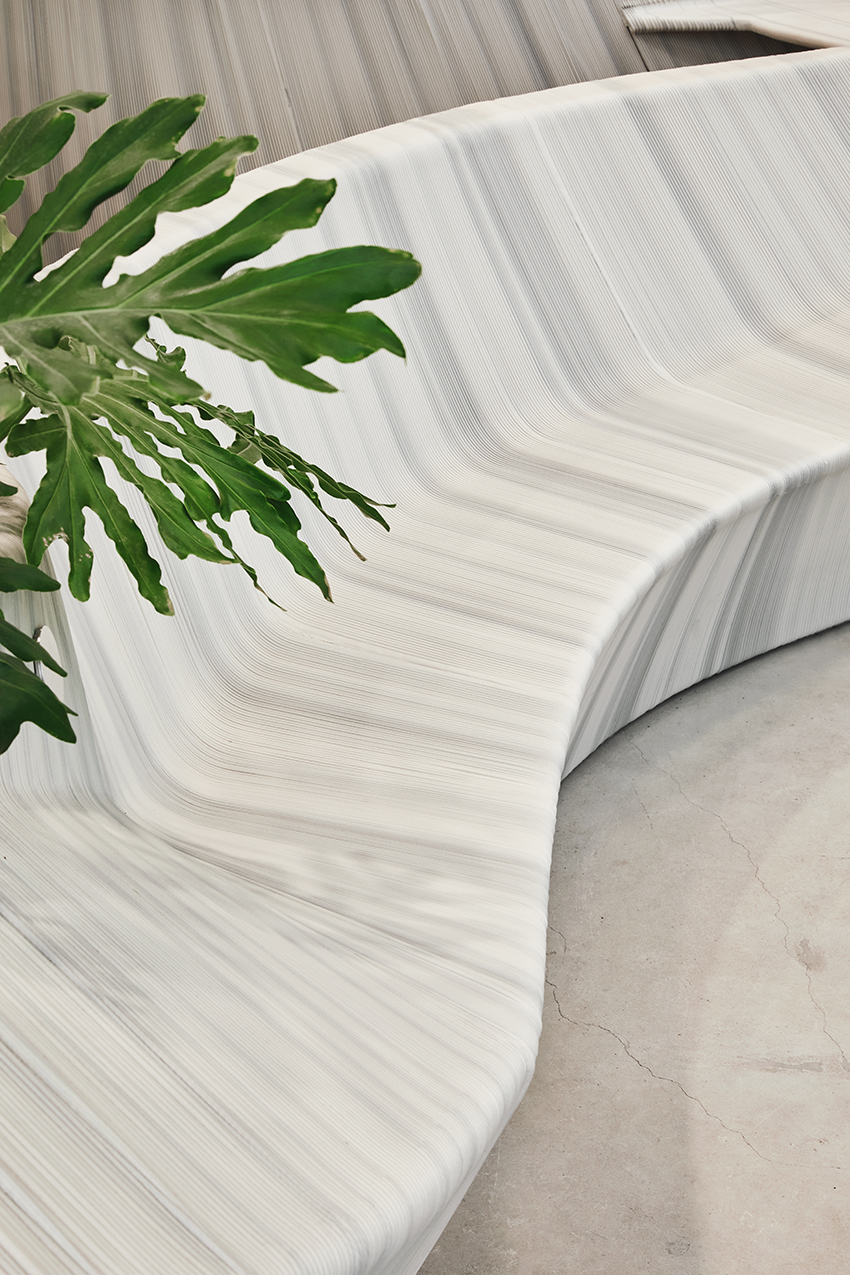
Beauty in layers: Plastic waste becomes a diverse, bespoke rock formation.
© Photo: Pim Top/ Michele Margot
The project transforms 880 kilograms of plastic waste into a new kind of "stone", simulating rock formations through a sophisticated technique that creates a 3D sculpture. Just as natural layers of fossil sediments are compacted and lithified over time, so with Stratum a new layer begins to be deposited on top of the previous one until it takes on its final massive form. Some layers are deformed into curves by later movements when the sediments were still soft. To reinforce the metaphor of the geological process, the rounded silhouette is the result of a tentative aesthetic that combines design, robotics and craftsmanship, deliberately giving the work an artisanal flair. Grey brushstrokes on a cream ground are added at randomly planned intervals and in constantly varying orientations. The resulting colour is inspired by supermarket stacking boxes - a subtle nod to the customer - while the texture enhances the earthy character of the furniture.
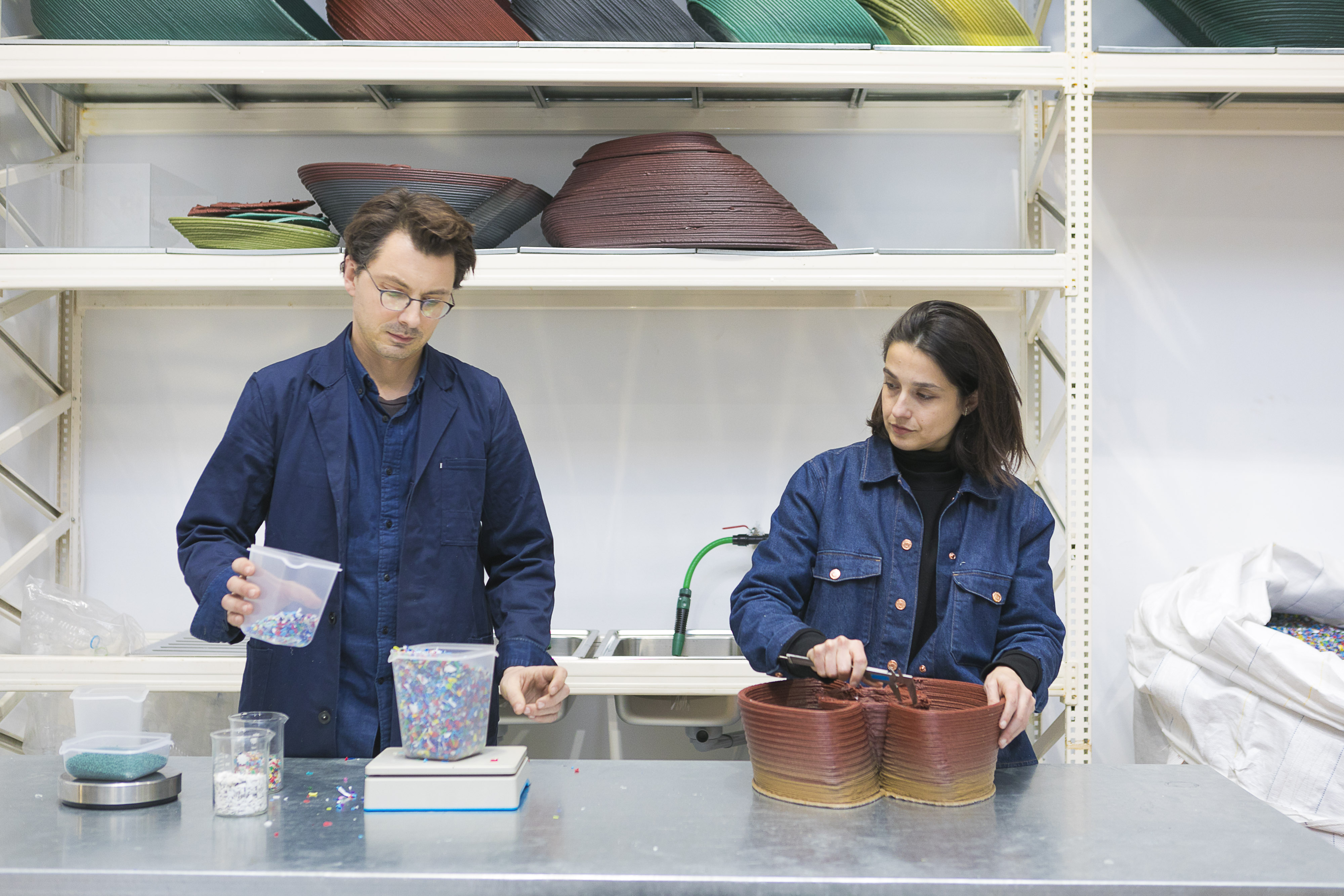
The designers of The New Raw at the Print Your City - Zero Waste lab in Thessaloniki.
© Photo: Stefanos Tsakiris
Stratum is a bespoke piece of furniture that maximises functions and adapts to different situations. It is suitable for offices, receptions, waiting rooms or catering. With its solid form, it choreographs an interior landscape that invites intuitive exploration with its curved lines. "Playing and interacting with Stratum stimulates the senses and creates engagement with others. Materiality is an important factor in our research as it plays an important role in our mental, visual and physical perception of a space," explain Panos Sakkas and Foteini Setaki, both architects and the studio's co-founders. "In this case, Stratum enhances the character and functionalities of an ordinary entrance hall while providing a sense of familiarity, putting visitors at ease."
Originally written by Barbara Jahn